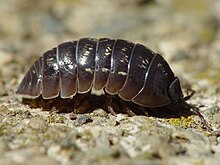Armadillidium vulgare
| Armadillidium vulgare | |
|---|---|
 |
|
| Scientific classification | |
| Kingdom: | Animalia |
| Phylum: | Arthropoda |
| Subphylum: | Crustacea |
| Class: | Malacostraca |
| Order: | Isopoda |
| Suborder: | Oniscidea |
| Family: | Armadillidiidae |
| Genus: | Armadillidium |
| Species: | A. vulgare |
| Binomial name | |
|
Armadillidium vulgare Latreille, 1804 |
|
| Synonyms | |
|
|
| External identifiers for Armadillidium vulgare | |
|---|---|
| Encyclopedia of Life | 1021952 |
| ITIS | 93250 |
| NCBI | 13347 |
| Also found in: | |
Armadillidium vulgare, the (common) pill-bug, (common) pill woodlouse, roly-poly, doodle bug, or carpenter, is a widespread European species of woodlouse. It is the most extensively investigated terrestrial isopod species.
Armadillidium vulgare may reach a length of 18 millimetres (0.71 in), and is capable of rolling into a ball when disturbed; this ability, along with its general appearance, gives it the name pill-bug and also creates the potential for confusion with pill millipedes such as Glomeris marginata. It can be distinguished from Armadillidium nasatum and Armadillidium depressum, the only other British species in the genus, by the gap that A. nasatum and A. depressum leave when rolling into a ball; A. vulgare does not leave such a gap.
Armadillidium vulgare is able to withstand drier conditions than many other woodlouse species, and is restricted to calcareous soils or coastal areas. It feeds chiefly on decaying plant matter, but also grazes lichens and algae from tree bark and walls.
It is able to regulate its temperature through its behaviour, preferring bright sunshine when temperatures are low, but remaining in shadow when temperatures are high; temperatures below −2 °C (28 °F) or above 36 °C (97 °F) are lethal to it.A. vulgare is less susceptible to cold during the night, and may enter a state of dormancy during the winter in order to survive temperatures that would otherwise be lethal.
The native distribution of A. vulgare ranges across Europe, especially in the Mediterranean Basin. In the United Kingdom, A. vulgare is very common in southern and eastern England, but is more confined to coastal areas in the north. Similarly, in Ireland, A. vulgare is common in the south and east, but rarer in the north and west.
...
Wikipedia
